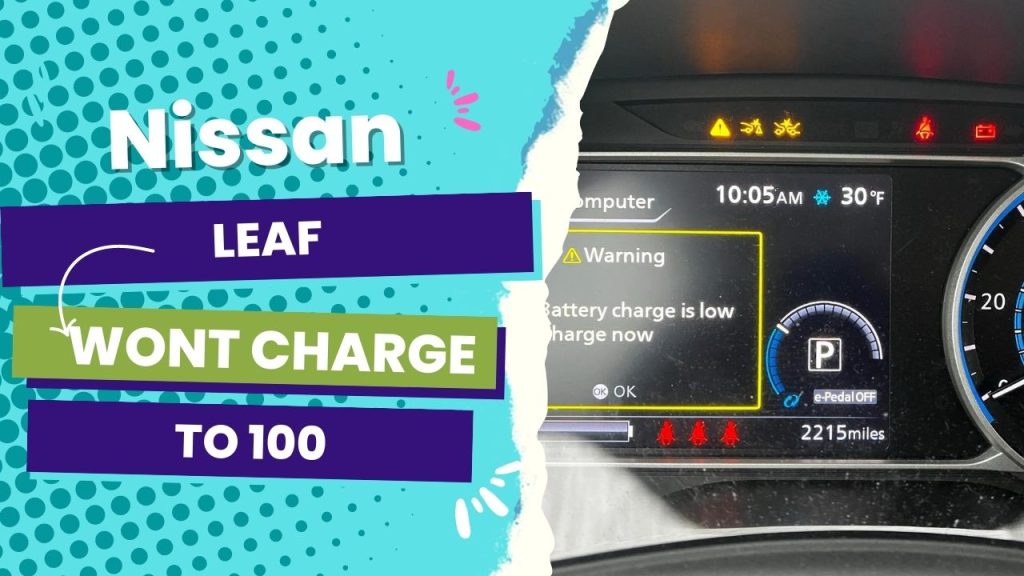Your Nissan Leaf may not be charging fully due to a low upper charge limit, a low battery state of health, a timer that’s not set, or a faulty charger. Most of the time, this problem could be fixed by turning off all the timers or removing the upper charge limit.
Problems with charging the Nissan Leaf to full capacity may be the result of many factors, including but not limited to battery age or faulty charging hardware. This is a common problem, and it seems to be worse in colder climates or with vehicles that have been driven a lot.
The Nissan Leaf is a good electric car, but many owners find that their cars do not live up to the advertised range. Owners are reporting that their cars won’t charge to 100%. If you have this same problem, this post will show you how to solve it in simple steps.
You Can Skip To Sections Here
Why is the Nissan Leaf not charging 100%?
The Nissan Leaf is an electric vehicle produced by Nissan. The Leaf is powered by a 62 kWh battery and has a range of 226 miles on a full charge. However, some owners have noticed that their Leaf’s battery does not charge to 100%.
There are a few possible explanations for this.
1. You have set a low upper charge limit.
Older Leafs let you set the charge limit, but you cannot set the battery charge limit in the latest Leaf, especially in the 2014 model.
Nissan Leaf electric vehicles have a built-in battery management system, and once it reaches a certain level, known as the “Upper Charge Limit,” it immediately stops charging the battery. As a result, the battery is protected and has a longer lifespan.
The maximum charge level may be too low if your Nissan Leaf isn’t charging 100%. Overcharging the battery can cause it to malfunction, so getting this setting right is crucial.
If you set the Upper Charge Limit too low, the charging process may be interrupted before your car is fully charged. You can try adjusting the upper charge limit or consulting a Nissan technician to solve this problem.
2. Your battery’s state of health is low.
The battery’s state of health indicates the overall health of the battery in your electric vehicle. You can see how much power the battery had lost compared to when it was brand new. If the battery’s health score is low, it has degraded and lost some of its capacity to store energy over time.
Your Nissan Leaf may not charge completely if the battery’s health is poor. Because the battery management system’s job is to keep the battery safe, it may reduce the charge given to the battery if it detects that the battery isn’t in good shape. This is done to ensure the battery’s longevity and prevent further damage.
The battery’s performance on your Nissan Leaf will be heavily dependent on the condition of the battery. There’s a chance that your car won’t charge to total capacity if your health isn’t great. A battery’s health can be assessed by tracking metrics like its percentage, available range, watt-hours, maximum capacity, and kW size when new.
The battery state of the health display will show you the following information below:
- Battery percentage
- Range available
- Watt hours/miles
- kW size of the battery at new
3. The timer is not set.
When you set your charging timer on your Nissan Leaf, The charging will not begin until it reaches the time you set. But you can set your battery to start charging immediately. Once you activate the battery to charge immediately, your battery will start charging immediately.
4. Problem with the Charger
If your fast charger has issues, charging 100 may become a problem. So, it is important to ensure your charger is up to standard. Power off the charger for about one minute and reset the charger.
How To Fix Nissan Leaf Not Charging To 100
If you have a Nissan Leaf and cannot charge it to 100%, there are a few things you can do to try and fix the issue.
1. Set the time limit to charge immediately.
To set your battery timer to charge immediately, you must do it on your touchscreen. Select Timer 1 or 2 to know if a timer is set on the car. If it is not, you can set it to charge immediately. You can also set the timer for different days based on your daily schedule.
2. Force your Nissan Leaf to charge to 100
Since you can no longer set the time limit in the Nissan Leaf, you can still force it to charge to 100%. The best way to do this is through the app. However, you must complete your SOH calculation to get the correct number you will enter when calibrating the app.
Here is how to calculate the SOH: For an accurate calculation, get an OBD dongle (OBD-II). Plug the OBD into the OBD port of your car—under your steering wheel. The OBD will immediately begin to connect to your Leaf.
Download the “Leaf Spy Lite” app and connect it to your Leaf’s computer via the OBD dongle. After downloading the app, you need to open it to connect to your Leaf, ensuring it is on. The app will show that it has connected to your car.
You will see several color bars on the battery cells in the app. Look for the SOH at the top of the bars. For instance, if your SOH is 70%, it means your battery had lost 30% capacity out of 100% when it was new. That is a 30% degradation.
The app also provides you with more information, such as State of Charge (SOS) accuracy, level 1 and level 2 sessions, the number of QCs (quick charging sessions), etc.
The app will also help you identify the battery cell that is not functioning to its full capacity.
After calculating the SOH, follow these steps to force your Leaf to charge to 100:
- Open the Juice Box
- Choose “My Vehicles”
- In the right corner, choose “Edit.”
- Enter the battery capacity.
When you finish calibrating the battery, you can set the charge percentage. Take note of the battery’s state of charge (SOC). Plug your car in to charge and follow these steps to force it to charge to 100:
- Open your app and navigate to the charging screen.
- Tap it and hold until “Plugged in with” shows up.
- Use your finger to move the dial to the SOC number.
- Tap and hold, and then move the dial to 100%.
The accuracy of your calculation will determine the finished charge rate. So, you may need to make a change if the charge is not getting to 100%.
3. Remove the charging timer.
Remove all charging timers and all preheating timers. When you do this on your Nissan Leaf, you should be able to charge it to 100%.
4. You Do Not Need To Charge To 100
If you own a Nissan Leaf, you may have heard that charging the battery to 100% all the time can degrade the battery and shorten its life. This is true. So, you don’t need to charge to 100% all the time to extend the life of your battery. Charging to 100% only occasionally is better for the battery.
So, what’s the best way to extend the life of your Nissan Leaf battery? First, avoid charging 100% all the time. Second, don’t let the battery drop below 20% too often. These two simple tips will help you keep your battery healthy and prolong its life.
Should I Charge My Nissan Leaf To 100
Yes, but it should not always be. Many Nissan Leaf owners have one burning question: should they charge their cars to 100%? There are a few different schools of thought, and there is no right or wrong answer. It all comes down to personal preference and how you plan to use your car.
If you like to have a full tank of gas all the time, then charging your Nissan Leaf 100% is probably the way to go. This way, you’ll always have a full charge, and you won’t have to worry about running out of juice.
On the other hand, if you don’t mind topping off your charge now and then, you can probably get away with charging to 80% or so. This can help extend the life of your battery and save you some money on your electric bill.
Ultimately, it’s up to you and what works best for your driving habits and lifestyle. But, charging to 100 all the time may shorten your battery’s lifespan than when charging 100 percent below.
Conclusion
The Nissan Leaf is a popular electric car, but you may encounter the problem of not charging 100%. This can be frustrating, but you can do a few things to fix it.
First, check the timer and ensure it is set to charge immediately. If that doesn’t work, you can try forcing it to charge to 100 by following the above steps. These should help get your car back to full power.

